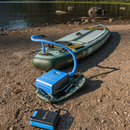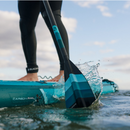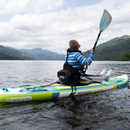Are Paddle Boards Safe? Debunk the Myths

Paddle boarding has become a wildly popular water sport that allows you to explore lakes, rivers, and oceans while getting in a full-body workout. But the burning question for newcomers and skeptics alike is, "is paddle boarding dangerous?" Let's dive in and debunk some common myths, all while offering sound advice to make your paddle boarding experience as safe as it is enjoyable.
Are Paddle Boards Safe?
Paddle boarding is generally a safe and enjoyable activity for people of all skill levels, especially when compared to other water-based activities. However, like any sport, it carries inherent risks and paddle board safety largely hinges on preparation, awareness, and environmental respect.
Proper preparation includes having the right gear, knowing local regulations, and being physically prepared. Respecting changing conditions and being mindful of other water users are also key to ensuring a safe experience. Therefore, the sport's safety level is primarily determined by your actions and preparedness.
Is Paddle Boarding Dangerous?
Paddle boarding is generally considered a safe and beginner-friendly water activity, but like any sport, it comes with risks if precautions aren’t taken. The majority of paddle boarding accidents happen due to carelessness or ignoring safety guidelines, rather than the activity itself being inherently dangerous.
In 2020, paddle sports accounted for 26% of all boating fatalities in the U.S., with 202 deaths reported. Notably, nearly 75% of those who died had less than 100 hours of experience, and over a third had less than 10 hours. Statistics show that most incidents involve factors like not wearing a life jacket, venturing too far from shore, or underestimating weather and water conditions. Is paddle boarding dangerous? Not inherently—but improper use or lack of preparation can make paddle boarding dangerous.
To stay safe, always wear a life jacket, avoid alcohol, gain proper training, and be mindful of weather and water conditions. Avoid paddling in areas with strong currents or heavy boat traffic, especially if you’re new. By following these simple rules, paddle boarding can be a safe, enjoyable, and incredibly rewarding experience!
10 Common Mistakes to Avoid When Paddle Boarding
Avoid pitfalls on the water by steering clear of these 10 common mistakes often made while paddle boarding. Knowledge is power—stay safe and paddle smart!
1. Lack of Proper Training
Many folks jump on a SUP board without understanding the basics like balance, paddling techniques, and board maneuvering. This lack of knowledge can lead to easily preventable accidents.
Take a Lesson: If you're new to the sport, consider taking a paddle boarding lesson from a qualified instructor.

2. Ignoring Weather Conditions
The sky may be blue when you start, but the weather can change in an instant. Being attentive to early warning signs can help you take timely action, such as seeking shelter or returning home, thereby minimizing risks associated with sudden weather changes.
Check Weather Conditions: Always consult weather forecasts before heading out. If you see dark clouds looming or feel a sudden drop in temperature, it might be best to reschedule your adventure.
3. Inadequate Safety Gear
Life jackets, leashes, and a whistle are not just for show. You should not treat safety gear as optional, but as essential tools that could potentially save your life in emergency situations.
Well Equipped with Safety Gear: Always ensure you have the necessary safety gear before heading out onto the water. Is it safe to paddle board alone? Well, if you must go solo, never skimp on safety gear.

4. Overestimating Abilities
Paddle boarding might appear simple, but it's unwise to overrate your skills, particularly if you're new to the sport or unfamiliar with the specific water conditions. Underestimating these factors can jeopardize your safety by creating hazardous situations.
Know Your Limits: Stick to calm waters initially and progress gradually as you get more confident and skilled. How safe is paddle boarding? It's often as safe as the user's skills and decisions.
5. Neglecting Board Maintenance
Even the best paddle boards require regular upkeep to ensure they're in optimal condition. A small leak or a loose fin may seem minor but can cause big problems when you're far from shore, potentially compromising your safety and enjoyment.
Regularly Assess Your Paddle Board's Condition: Always check your inflatable SUP for any wear and tear before you head out.
6. Disregarding Local Regulations
Disregarding the specific rules and regulations of a waterway can draw unwanted attention from law enforcement and also put you and others at risk. These guidelines are in place to ensure safety and preserve the local environment.
Follow Local Guidelines: Respect no-entry zones, speed limits, and any other local rules.

7. Ignoring Your Physical Limits
Paddle boarding is a full-body workout that engages multiple muscle groups. Overdoing it, especially if you're not adequately conditioned or used to physical exertion, can lead to muscle cramps, exhaustion, and even increased risk of injury or accidents on the water.
Listen to Your Body: If you start to feel fatigued or dizzy, it’s time to head back to shore.
8. Neglecting Hydration
When paddle boarding, especially in warm climates or during prolonged physical activity, dehydration becomes a significant risk. Insufficient hydration can result in symptoms such as fatigue, dizziness, and poor decision-making, posing extra dangers while on the water.
Stay Hydrated: Always bring enough water, especially if you plan to be out for an extended period.

9. Not Being Aware of Surroundings
Many accidents happen on the water because people are not paying attention to other watercraft, swimmers, or obstacles like rocks and buoys in the water. Being inattentive not only puts you at risk but can also endanger others who share the waterway with you.
Stay Alert: Watch for other vessels, marine life, and environmental hazards. Paddle boarding can become dangerous if you're not aware of your surroundings.
10. Risky Behavior
Thrill-seeking has its place, but not when you're learning a new water sport like paddle boarding, especially in an unfamiliar setting. Taking unnecessary risks can escalate the danger level rapidly, putting you and potentially others at risk for accidents or injuries.
Avoid Risks: Paddle boarding near boats, taking on waves that are too big, or venturing too far from shore can turn an delightful day into a dangerous one quickly.
Explore the Waterways Safely and Confidently with iROCKER
So, are paddle boards safe? The answer largely depends on how you approach it. With the right precautions and respect for the sport and nature, paddle boarding can be an incredibly enjoyable and relatively low-risk activity. Keep it safe, folks, and happy paddling!
FAQ:
1. Is paddle boarding safe for non swimmers?
Yes, it’s possible for non-swimmers to enjoy paddleboarding safely, but extra precautions are essential. Wearing a life jacket is non-negotiable—it’s your primary safety tool in case you fall in. Using a leash to keep your board within reach is also crucial, as it serves as your flotation device. While paddle boarding isn’t inherently dangerous, non-swimmers should stick to calm waters, avoid windy conditions, and paddle close to the shore for added safety. With the right preparation and awareness, you can enjoy the experience confidently—even if swimming isn’t your strength!
2. How deep is the water for paddle boarding?
While 10 inches of water might seem suitable for getting started, it’s not ideal for paddle boarding as the fins can hit the sand or rocks, causing instability. Beginners should aim for water that’s at least 20 inches deep, which allows enough clearance for the board to glide smoothly and provides a safer experience as you build confidence.






